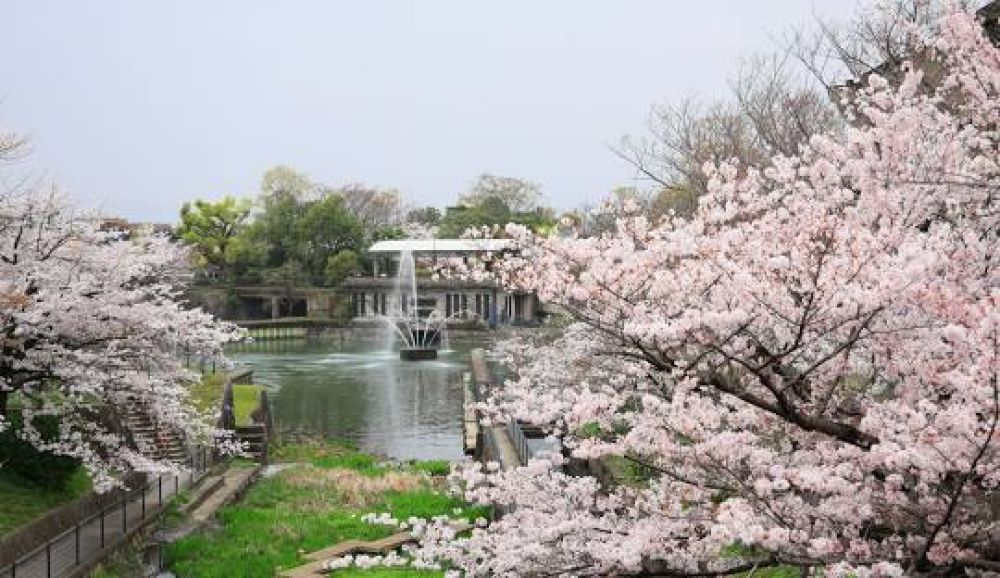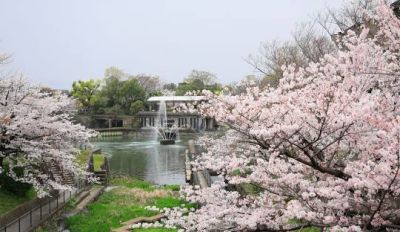

Visitors to Nanzenji, which is considered one of the most important Zen temples in Japan, can explore the sprawling temple grounds. The expansive complex features stunning gardens, sub-temples, and the iconic Sanmon gate, which offers panoramic views of Kyoto after climbing to the top. The temple grounds also include a large brick aqueduct that passes through the temple grounds, which is part of the Lake Biwa Canal. The picturesque setting provides opportunities for meditation, relaxation, and photography. The aqueduct, in particular, is a unique fusion of Western and Eastern architectural styles and provides a scenic backdrop for a leisurely stroll. Visitors can admire the changing seasons, with cherry blossoms in spring and rich autumn colors in the fall, making the temple grounds an ever-changing tapestry of natural beauty.
The Tenjuan Garden is one of the many sub-temples within Nanzenji that has a separate admission fee. It features two distinct types of gardens: a rock garden representing the Zen philosophy and a pond garden that changes with the seasons. Visitors can experience the calming influence of the meticulously raked gravel in the rock garden and enjoy the serene beauty of the carp-filled pond surrounded by carefully manicured foliage. The play of light and shadow, the subtle hues of green, and the tranquility of the setting offer a moment of peaceful contemplation. Tenjuan is particularly famous for its autumn foliage when the maples surrounding the pond turn a vibrant red, creating a stunning contrast with the backdrop of the temple's moss-covered roofs.
The Hojo, the former head priest's residence, is at the heart of the Nanzenji Temple complex. The Hojo's gardens are considered masterpieces of Japanese rock garden design. Created by notable landscape gardeners, they use rocks, gravel, moss, and pruned shrubs to represent islands, mountains, and waterfalls. Each angle offers a distinct view, designed to symbolize Zen concepts and inspire introspection. Visitors to the Hojo can sit on the veranda and gaze upon the gardens, using the opportunity to engage in meditation or just to enjoy the silent beauty of the space. The gardens are meticulously maintained, providing a timeless sense of harmony and balance that reflects the underlying principles of Zen Buddhism.
A unique feature of the Nanzenji Temple complex is the Suirokaku aqueduct, which crosses the grounds. The aqueduct dates back to the late 19th century and remains an intriguing piece of Meiji-period engineering. Visitors can actually walk along the path that runs alongside the aqueduct, offering a different perspective of the temple grounds and surrounding forest. This walk combines a sense of history with natural beauty, as the aqueduct's structure blends surprisingly well with the aesthetic of the temple and its gardens. While strolling along this architectural marvel, guests can appreciate the contrast between the flowing water and the sturdy brick construction, providing ample opportunities for photography or simply enjoying the peaceful ambiance.
Konchi-in is another sub-temple of Nanzenji and is known for its beautiful crane and turtle gardens. Designed by a famed landscape architect, Kobori Enshu, in the Edo period, the gardens at Konchi-in are a spatial masterpiece. Thematically, the crane garden represents longevity, while the turtle garden symbolizes immortality, reflecting important symbols in Japanese culture. Visitors can view the gardens from the temple's porch, which acts as a 'borrowed scenery' backdrop, integrating the surrounding landscape into the composition. Being smaller and less crowded than the main temple grounds, Konchi-in offers a more intimate and peaceful experience for visitors looking to enjoy traditional Japanese landscape design in a quiet and contemplative setting.
The Sanmon Gate is one of Nanzenji's most prominent structures. As the main gate of the temple, it stands at an impressive height and offers visitors a chance to climb to the upper balcony. This ascent involves passing through the temple's entsuin, or paid garden area, and up a set of steep stairs leading to the balcony. From there, visitors are awarded a stunning view of Kyoto and the surrounding hills. The Sanmon Gate is not only a significant architectural highlight, but its vantage point provides one of the best panoramic views available in the temple complex. Gazing out from the balcony, visitors can reflect on the historic significance of the gate, which has been a silent witness to many chapters of Kyoto's history.
Art enthusiasts and those interested in traditional Japanese culture will appreciate the occasional ink painting workshop offered at Nanzenji Temple. Conducted by local artists or monks proficient in the art, participants learn the basics of sumi-e, the delicate art form of Japanese ink painting. Visitors are guided through the process of using different brush strokes to create representations of various elements of nature, emphasizing simplicity and depth. The workshop not only provides a hands-on artistic experience but also serves as a meditative practice, encouraging mindfulness and concentration. It's a unique way to connect with traditional Japanese artistry while creating a personal souvenir to take home.
Nanzenji, being a Zen temple, offers visitors a chance to experience zazen (Zen meditation). Under the guidance of a Zen monk, participants are taught proper sitting posture and breathing techniques to help still the mind and body. The meditation experience is a spiritual highlight, providing a deeper understanding of Zen practices and philosophies. This immersive activity takes place in a quiet hall or garden area within the temple grounds, allowing for a serene environment conducive to introspection and self-discovery. It's an opportunity to unplug from the distractions of modern life and to engage with core elements of Japanese spirituality.
For those interested in 'sado' or the 'way of tea,' experiencing a tea ceremony at Nanzenji Temple provides a window into this refined Japanese cultural practice. A tea ceremony is a choreographed ritual of serving and drinking matcha, or powdered green tea. In the peaceful surrounds of the temple, participants can observe the precision and grace with which the tea is prepared and served by a tea master. This centuries-old tradition is also an act of hospitality and mindfulness. The experience is not just about drinking tea, but also about aesthetics, observing etiquette, and enjoying the tranquil setting. Visitors are often served a traditional Japanese sweet before receiving their bowl of matcha, which complements the tea's bitterness and enhances the overall sensory experience.
Throughout the year, Nanzenji Temple hosts various seasonal events and festivals that bring additional color and liveliness to the temple grounds. The most notable are during the sakura (cherry blossom) season in spring and the koyo (autumn leaves) season in fall, where special night illuminations may highlight the beauty of the temple gardens draped in seasonal splendor. During these events, the gardens are often open later than normal, and special lighting creates a magical atmosphere. The temple complex may also host religious ceremonies, traditional performances, or cultural exhibitions that coincide with significant dates on the Buddhist calendar or national holidays. Participating in these events provides a chance to experience Japanese traditions and festivities first hand in a historic and spiritual setting.
